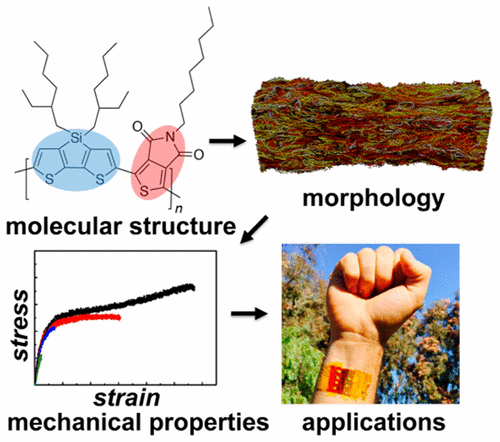当前位置:
X-MOL 学术
›
Chem. Rev.
›
论文详情
Our official English website, www.x-mol.net, welcomes your feedback! (Note: you will need to create a separate account there.)
Mechanical Properties of Organic Semiconductors for Stretchable, Highly Flexible, and Mechanically Robust Electronics
Chemical Reviews ( IF 62.1 ) Pub Date : 2017-03-25 00:00:00 , DOI: 10.1021/acs.chemrev.7b00003 Samuel E. Root 1 , Suchol Savagatrup 1 , Adam D. Printz 1 , Daniel Rodriquez 1 , Darren J. Lipomi 1
Chemical Reviews ( IF 62.1 ) Pub Date : 2017-03-25 00:00:00 , DOI: 10.1021/acs.chemrev.7b00003 Samuel E. Root 1 , Suchol Savagatrup 1 , Adam D. Printz 1 , Daniel Rodriquez 1 , Darren J. Lipomi 1
Affiliation

|
Mechanical deformability underpins many of the advantages of organic semiconductors. The mechanical properties of these materials are, however, diverse, and the molecular characteristics that permit charge transport can render the materials stiff and brittle. This review is a comprehensive description of the molecular and morphological parameters that govern the mechanical properties of organic semiconductors. Particular attention is paid to ways in which mechanical deformability and electronic performance can coexist. The review begins with a discussion of flexible and stretchable devices of all types, and in particular the unique characteristics of organic semiconductors. It then discusses the mechanical properties most relevant to deformable devices. In particular, it describes how low modulus, good adhesion, and absolute extensibility prior to fracture enable robust performance, along with mechanical “imperceptibility” if worn on the skin. A description of techniques of metrology precedes a discussion of the mechanical properties of three classes of organic semiconductors: π-conjugated polymers, small molecules, and composites. The discussion of each class of materials focuses on molecular structure and how this structure (and postdeposition processing) influences the solid-state packing structure and thus the mechanical properties. The review concludes with applications of organic semiconductor devices in which every component is intrinsically stretchable or highly flexible.
中文翻译:

可拉伸,高度柔性和机械坚固的电子产品的有机半导体的机械性能
机械变形性巩固了有机半导体的许多优点。但是,这些材料的机械性能是多种多样的,允许电荷传输的分子特性会使材料变硬和变脆。这篇综述是对控制有机半导体机械性能的分子和形态学参数的全面描述。特别注意机械变形性和电子性能可以共存的方式。这篇综述首先讨论了所有类型的柔性和可拉伸设备,尤其是有机半导体的独特特性。然后讨论了与可变形设备最相关的机械性能。特别是描述了低模量,良好的附着力,断裂前的绝对可延展性具有强大的性能,如果戴在皮肤上,则具有机械上的“不易察觉性”。在对计量技术进行描述之前,先讨论三类有机半导体的机械性能:π共轭聚合物,小分子和复合材料。每种材料的讨论都集中在分子结构以及这种结构(以及后沉积过程)如何影响固态堆积结构以及机械性能方面。该综述以有机半导体器件的应用结束,其中每个组件本质上都是可拉伸的或高度柔性的。在对计量技术进行描述之前,先讨论三类有机半导体的机械性能:π共轭聚合物,小分子和复合材料。每种材料的讨论都集中在分子结构以及这种结构(以及后沉积过程)如何影响固态堆积结构以及机械性能方面。该综述以有机半导体器件的应用结束,其中每个组件本质上都是可拉伸的或高度柔性的。在对计量技术进行描述之前,先讨论三类有机半导体的机械性能:π共轭聚合物,小分子和复合材料。对每种材料的讨论都集中在分子结构以及这种结构(以及后沉积过程)如何影响固态堆积结构以及机械性能方面。该综述以有机半导体器件的应用结束,其中每个组件本质上都是可拉伸的或高度柔性的。每种材料的讨论都集中在分子结构以及这种结构(以及后沉积过程)如何影响固态堆积结构以及机械性能方面。该综述以有机半导体器件的应用结束,其中每个组件本质上都是可拉伸的或高度柔性的。每种材料的讨论都集中在分子结构以及这种结构(以及后沉积过程)如何影响固态堆积结构以及机械性能方面。该综述以有机半导体器件的应用结束,其中每个组件本质上都是可拉伸的或高度柔性的。
更新日期:2017-03-25
中文翻译:

可拉伸,高度柔性和机械坚固的电子产品的有机半导体的机械性能
机械变形性巩固了有机半导体的许多优点。但是,这些材料的机械性能是多种多样的,允许电荷传输的分子特性会使材料变硬和变脆。这篇综述是对控制有机半导体机械性能的分子和形态学参数的全面描述。特别注意机械变形性和电子性能可以共存的方式。这篇综述首先讨论了所有类型的柔性和可拉伸设备,尤其是有机半导体的独特特性。然后讨论了与可变形设备最相关的机械性能。特别是描述了低模量,良好的附着力,断裂前的绝对可延展性具有强大的性能,如果戴在皮肤上,则具有机械上的“不易察觉性”。在对计量技术进行描述之前,先讨论三类有机半导体的机械性能:π共轭聚合物,小分子和复合材料。每种材料的讨论都集中在分子结构以及这种结构(以及后沉积过程)如何影响固态堆积结构以及机械性能方面。该综述以有机半导体器件的应用结束,其中每个组件本质上都是可拉伸的或高度柔性的。在对计量技术进行描述之前,先讨论三类有机半导体的机械性能:π共轭聚合物,小分子和复合材料。每种材料的讨论都集中在分子结构以及这种结构(以及后沉积过程)如何影响固态堆积结构以及机械性能方面。该综述以有机半导体器件的应用结束,其中每个组件本质上都是可拉伸的或高度柔性的。在对计量技术进行描述之前,先讨论三类有机半导体的机械性能:π共轭聚合物,小分子和复合材料。对每种材料的讨论都集中在分子结构以及这种结构(以及后沉积过程)如何影响固态堆积结构以及机械性能方面。该综述以有机半导体器件的应用结束,其中每个组件本质上都是可拉伸的或高度柔性的。每种材料的讨论都集中在分子结构以及这种结构(以及后沉积过程)如何影响固态堆积结构以及机械性能方面。该综述以有机半导体器件的应用结束,其中每个组件本质上都是可拉伸的或高度柔性的。每种材料的讨论都集中在分子结构以及这种结构(以及后沉积过程)如何影响固态堆积结构以及机械性能方面。该综述以有机半导体器件的应用结束,其中每个组件本质上都是可拉伸的或高度柔性的。



























 京公网安备 11010802027423号
京公网安备 11010802027423号